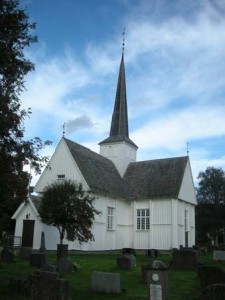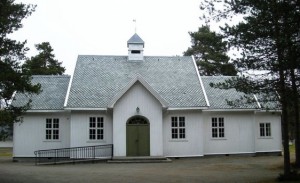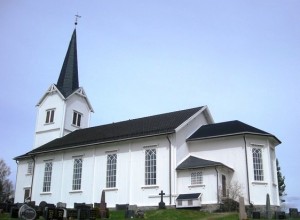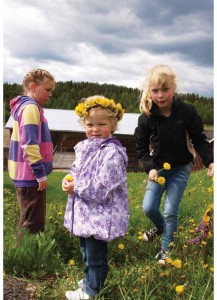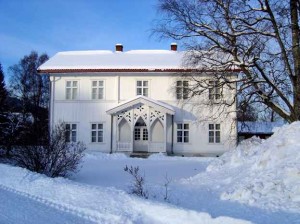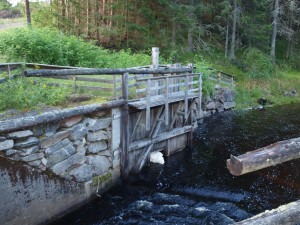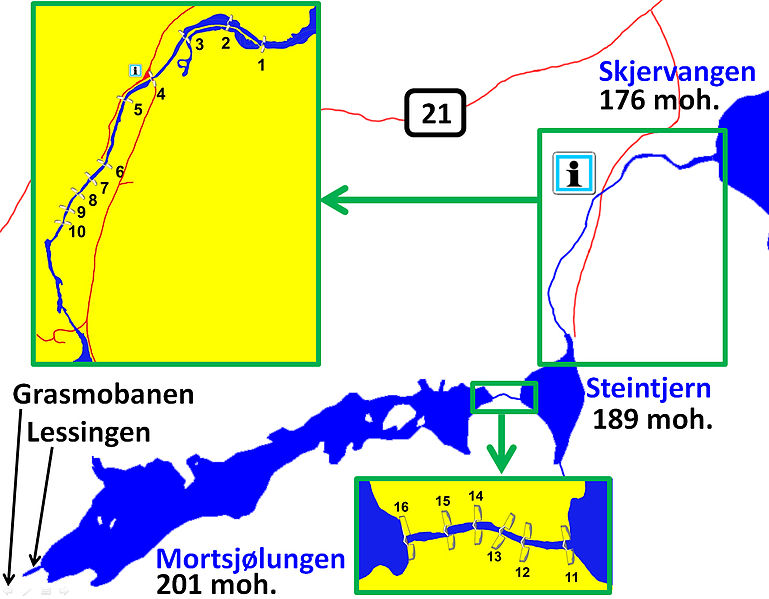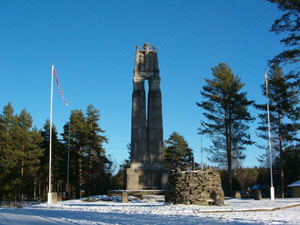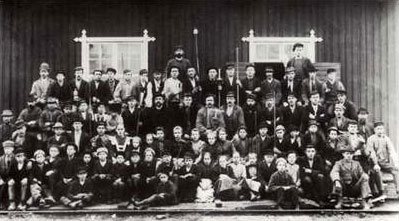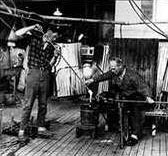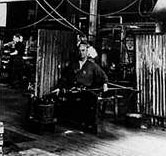CHURCHES
Eidskog church
Although Skotterud is the administration center in Eidskog, the church has been placed at Matrand since the Middle Ages. There are indications that it was stavechurch there in the 1100s Todays church is from 1665. There is a notched cross church built by Knut Mortensen and Oluf Wernersen (the tower). It has 350 seats and three galleries. The roof is covered with slate.
The church has a Baroque altarpiece from 1667, with a crucifix where Christ holds the crown rather than the crown of thorns, which is the usual. The font in soapstone is from the 1100s. A Jørgensen-organ from 1898 was restored in 1974. Of the three church bells are one from the Middle Ages. There is also an exhibition of coins and other artifacts from archaeological excavations in 1965.
http://norske-kirkebygg.origo.no/-/bulletin/show/476156_eidskog-kirke
Magnor church
The Magnor church was built as a chapel in 1923 and consecrated in 1924. Owner was then Magnor home mission. The church still do not seem to have its own parish, but belongs to Eidskog with the main church at Matrand.
Magnor church is a timber church with 100 seats. The architects name was Brenne, the sources do not mention his first name.
The following can be read out of the church lexicon with respect on inventory: The altarpiece, with resurrection scene, created by Finn Krafft in 1947. The pulpit, the same age as the church, is octagonal and made from builder Stensbøl. This also applies to the baptismal font. The church has an electronic organ from Eminent Omegan installed in 1985. Church bells are from 1923.
The church is surrounded by the cemetery, and there is also a chapel and a building. The cemetery is also a war memorial.
http://norske-kirkebygg.origo.no/-/bulletin/show/578128_magnor-kirke
Vestmarka church
Vestmarka church Eidskog is a wooden church from 1883 with 300 seats. The architect was Louis Bergh. The church has a rectangular nave and a narrower and lower, polygonal closed choir surrounded by the vestry and west tower . The church was originally an annex church in the Eidskog church parish , but have now its own.
Church Encyclopedia says the following: The altarpiece was made by Amund Hesbøl in 1933 and depicts the risen Christ. In the choir windows, on each side of the altar, it is glass paintings by Rolf Klemetsrud dated 1952. The pulpit (on the left in the chancel) has fillings with evangelist images. The organ is from Norwegian Organ and Harmoniumfabrikk installed in 1969, and the two church bells, installed in 1883, from Bochumer Verein.
http://norske-kirkebygg.origo.no/-/bulletin/show/577240_vestmarka-kirke
Eidskog folk museum Almenninga was officially opened on the cultural heritage day 10th of September year 2000. Eidskog now has a distinctive and natural folk museum, which is going to be a meeting place for generations of Eidskog residents in times to come. Eidskog folk museum differs from the other folk museums in the region, and can maybe be compared with the Swedish ancient farms museums. A museum working according to Eco museum model, operates according to historically and naturally facts. There are several factors that have contributed to choosing Almenninga as local museum. The name, the age, the location and the buildings gives a good visualization of the old building history in Eidskog.
The school law of 1860 decreed that there should be regular village schools and no longer homeschooling. Eidskog had at the most 19 village schools. In 2006 there were five village schools and one middle school.
Eidskog School Museum at Matrand was officially opened the 7th of June1985 as the first museum facility in Eidskog. EMH(Eidskog Museum and History association) took over the old Matrand school in 1980 from Eidskog municipality with the purpose to get a school museum for the entire municipality. This building had been a small school for Matrand in the years 1879 to 1971. It was natural to establish a school museum here. Matrand was the originally the administrative center for Eidskog municipality and the main church is still there. The school and the Church l belonged naturally together in old ages.
The school of Matrand was originally situated at the Eidskog vicarage. It worked as Community House building for the church, a place where people with long travel distances to the church could take in in order to change clothes and shape up before they entered the church. It also accommodated the priest every time when he came from Vinger to administer the church acts in Eidskog. Eidskog annex parish was separated by Vinger in 1859 with effect from 1860. At the vicarage came new living houses. In 1879 the Community House was moved down to the horse’s Mound near the church and got to start with three functions: VillageSchool for Matrand, community house for the church and administration building for the young municipality. Municipal administration was around 1900 moved to Skotterud.
Objects in the school museum is collected from the various village schools in Eidskog. The furnishings in the apartment are private teacher gifts for EMH.
The Soot channel is the first and in its time the largest water-locks system for timber operations in Norway, and was in operation from 1849 to 1930.
Engebret Soot channel system went from “Skjaervangen” in Eidskog to Gulltjerndammen in the former Setskog annex in the former Høland municipality. It was a combination of 16 water-locks (originally 15) between “Skjaervangen” and Mortskjoelungen and rail (Grasmo railroad) between Mortskjølungen and Tvillingtjern.
In addition to the water-locks and the railroad the system included control and damming of around 20 small lakes and streams. This gave a possibility to transport lumber from Skjervangen to Setten and then further into the Halden watercourse to the big lumber companies in Halden and Sarpsborg.
Norwegian Border pilot Museum is located in the old schoolhouse at “Skjølåbråten” by Vestmarka in Eidskog municipality.
The turnoff to the museum is between Skotterud and Bjørkelangen along Highway 21, an exit sign is posted by road and it is about 1 km ahead from the highway.
The purpose with the museum is to give insight border pilots and resistance peoples life and work
during the German occupation 1940-45. The collections exhibited at the museum belongs to the Association “Flyktningruta”(Refugee route)
From the schoolhouse it is only a few kilometers to the Swedish border, and a large number of refugees and resistance people found here a sheltered resting place before the dangerous crossing of the Swedish border and to freedom.
In the museum are the collected artifacts, the documents and the photographs in their correct setting, giving an realistic picture of the war-times harsh reality. The film Escape from
swastika is part of the in the exhibition.
The peace monument
The Swedish architect Lars Johan Lehming won the competition for the design. The monument were performed in white granite from Iddefjorden, an other boundary area between the two states.
The inauguration took place the 16th of august 1914. Then there had been 100 years since the two neighboring nations had an open state of war. The union was dissolved without war, showing the world how a conflict could be resolved peacefully.
12 000. visitors attended the inauguration, a big crowd for the time beeing.
The monument was up to the second world war central to several peace events. During the war it had a monumental value as a symbol for peace and better times. After the war the monument was really known through the joint Swedish Norwegian radio program Morokulien.
The area, known under the name Morokulien, houses a diverse range of commercial and none commercial offers, such as gas station, cafes, souvenir shops and MorokulienInfoCenter. http://www.morokulieninfocenter.com/
Magnor Glassworks
In the deep woods were Magnor Glassworks founded in 1896 – for more than 115 years ago. Skilled glass workers in several generations provide solid ground for knowledge and traditions of a company with historical traditions.
The Magnor Glassworks is built on tradition, determination and ambition. Today Magnor Glassworks is Hedmark’s biggest tourist attractions with approx. 220,000 visitors each year.
Supplier of good design since 1896
The glassworks was founded in 1896 in the deep forests which encircle the last village on the Norwegian side, just two miles from the border to Sweden and 70 miles from Oslo. The great forests have always been fuel for the heat consuming melting furnaces. The fire has never gone out..
Masters, glass blowers and artists are all professions that often follow family, from father to son, from adult to youth. Magnor Glassworks is no exception, where the glass has left its mark on an entire village for generations. Its history has been shaped by skilled glass workers. Together they build a solid foundation as the creators and forerunners of today’s unique production.
More than 115 years of tradition in handmade glass and crystal has provided valuable knowledge and experience.


